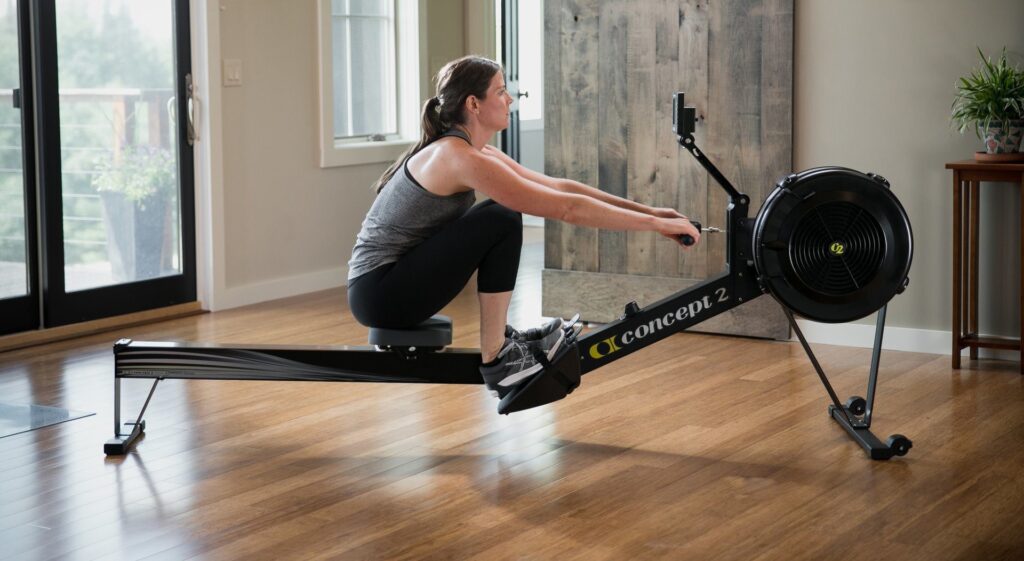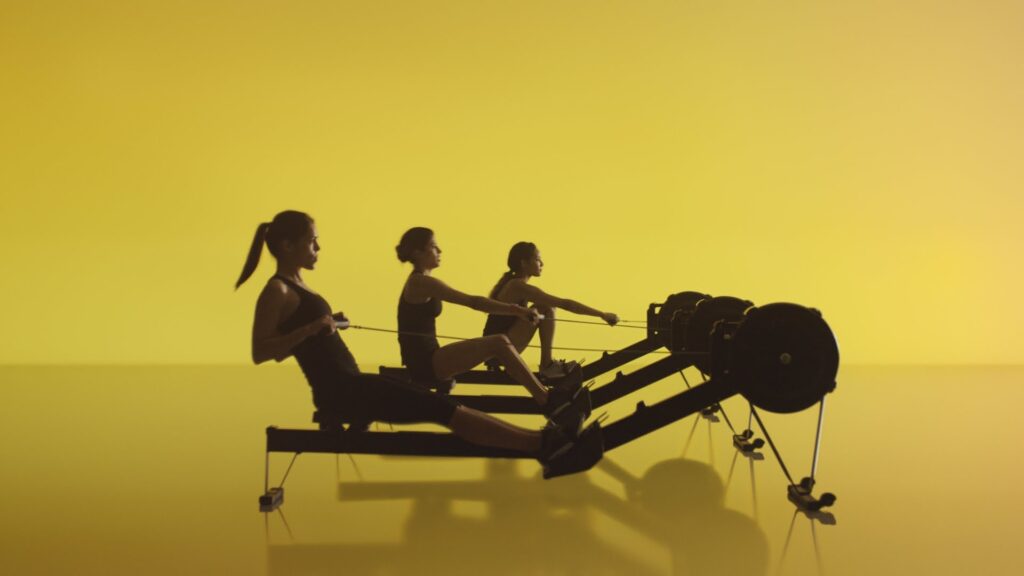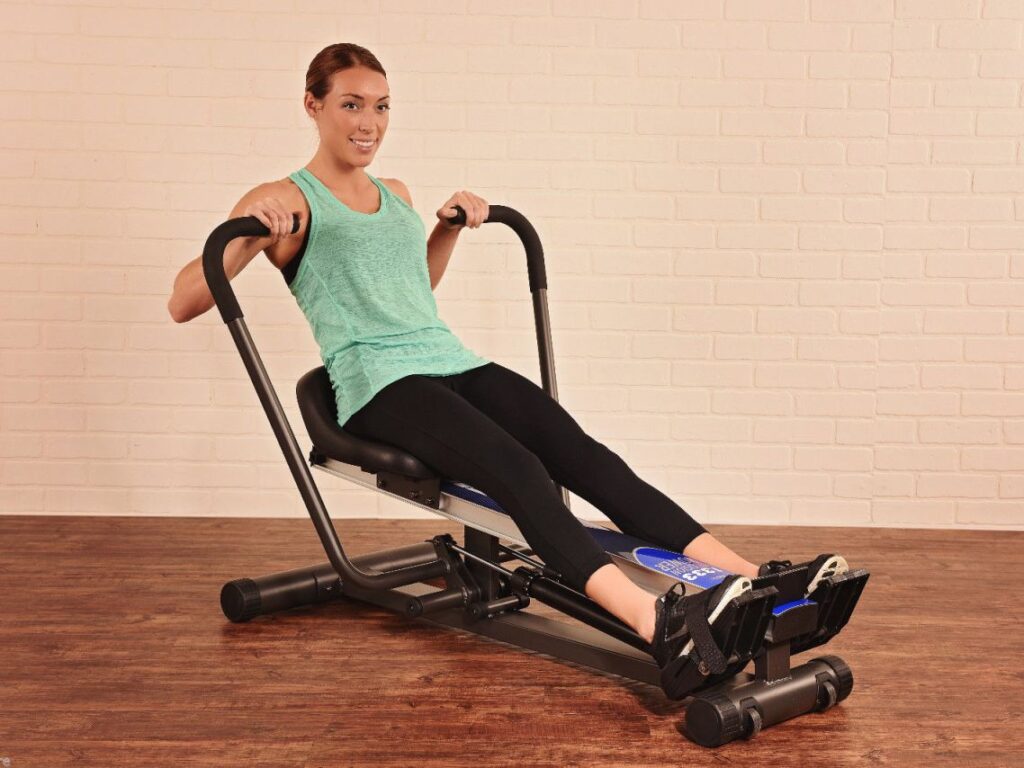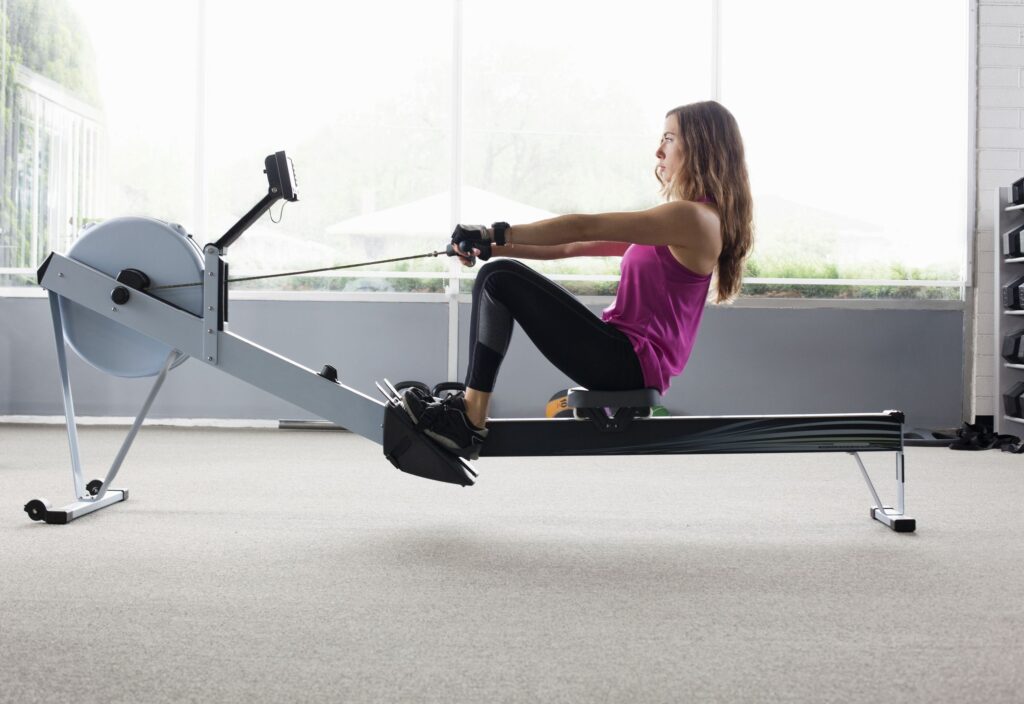If you wanted full body work out, then there’s nothing better than a rowing machine. With that being said, you may be wondering exactly what muscles do rowing machines work? That’s what we wanted to find out here.
There are four phases of a rowing machine workout: the catch, the drive, the finish, and the recovery. Learning these techniques can give you a better understanding of how to activate your lower/upper body and core muscles.
If you want to know whether you should get on one in the gym or buy the best rowing machine for your home, you must be fully aware of precisely how they can benefit you. Here we’ll look at how they work, what they work, and any additional benefits they give. Let’s get started!
Learning the phases of a rowing stroke can not only give you a better understanding of what muscles are used but also teach you how to row correctly. Unlike other machine-based exercises such as the treadmill, the rowing machine targets nine muscle groups, which comprises about 86% of the body’s muscles Trusted Source Page Expired Purpose: To examine the impact of low-intensity and a mixture of low- and high-intensity training on physiological and performance responses in rowing. insights.ovid.com .
The catch is the first phase of a rowing stroke, where you’re crouched forward near to the front of the machine. In doing so, you have to bend your knees closer to your chest while your lower leg should be vertical to the ground. When in that position, it will strengthen your triceps, legs, and back muscles.
When doing the catch motion, you have to extend your arms and elbows forward while your shins should be down vertically. Your back muscles will also give you firm support and muscle control.
The drive is when you push out from the catch position and pull back the bar. You have to push your foot off as you fully extend your legs and swing your body into an upright position. At the end of the stroke, your arms, shoulders, and handlebar should be close to your ribcage.
The drive will help strengthen your legs, shoulders, abs, and back, but more specifically on the hamstrings and glutes. When let your hips drive, your upper body should be leaning back into a 45-degree angle.
The finish is the end part of the drive, where you tuck the bar into your chest. During the finishing phase, you have to engage your core to maintain stability in your body. The momentum will allow you to extend your legs fully and allow the handle to be closer to your serum. At the same time, your upper arm will rotate in a rowing motion.
The finish phase will mostly strengthen your torso, which is made of 5 core muscles that include the rectus abdominis, internal abdominal oblique, external abdominal oblique, pyramidal, and transverse abdominis. Your biceps will also contract during this phase, and your back muscles also aid with stability.
The recovery phase is the final step of doing the rowing motion, which is doing the first three steps in reverse. First, you’ll have to extend your arms closer to the flywheel while keeping your arms parallel to the ground. Then you must bend your knees while your hamstrings are pulling you forward until you’re back in the catch position.
The recovery phase will make you control your motion and activate these muscle groups together. Your triceps and upper legs, and calves will all be working to return you to the starting position.
The muscular benefits of a rowing machine are clear. It’s known as the perfect exercise due to how much of your body will be working. It’s great for losing weight, improving your physical stability, and recovery from an injury. Here we take a deeper look into the benefits of a rowing machine.
Your muscular system is not the only part of your body that can benefit from rowing but also your cardiovascular system too. Since rowing gives you such an extensive workout, it also has a wonderful effect on keeping your heart rate elevated. This exercise is also used in aerobics because it strengthens your lungs to use oxygen more efficiently.
Although this is a strenuous activity compared to other machine-based exercises, rowing machines have lower risks. It’s a great way to reduce your risk of cardiovascular disease, and you could say that one of the rowing machine muscles targeted is your heart.
Other cardio machines require you to repeatedly impact your joints. Exercises such as stair climb, jumping, and running machines all have much higher impacts than with a rowing machine. This can put added pressure on your knees and ankles.
Rowing machines have a much lower impact. This is the primary reason why rowing machines are a perfect exercise as you’re very unlikely to get any joint pain, even after extensive use. This lack of impact also makes it ideal for those who are coming back from injuries as it can ease your body back into strenuous exercise.
The rowing machine is a great way to burn calories quickly. If you’re short on time throughout the way but still want a great workout, you can get that from one of these machines. Most of them allow you to have different levels of resistance where you can customize your workout.
Using the rowing machine exercise will also amplify the “afterburn effect”, where your body fats will continue to burn even after doing the exercise. In a 30-minute exercise, rowing exercise can burn more than 300 calories for the average person.
Not many machines are brilliant for losing weight and burning calories, but a rowing machine certainly ticks both of those boxes, partly due to it working so many of your muscles.
As mentioned above, this exercise is not just good for a specific muscle group, but it can work a wide range across your body. Rowing can condition your upper body, shoulder muscles, and lower back, as well as your leg muscles.
Every bit of your muscles is will be engaged to move and exercise. Due to this, you can tone your muscles throughout your body and get an even look, rather than having a dominant muscle group such as when lifting weights or running.
According to a 2015 study Trusted Source Effects of Indoor Rowing Exercise on the Body Composition and the Scoliosis of Visually Impaired People: A Preliminary Study The majority of visually impaired people do not participate in active sports due to efficiency and safety issues. Rowing is a safe whole-body exercise with aerobic and anaerobic components. www.ncbi.nlm.nih.gov , research was conducted of 24 people with low vision to participate in a rowing session for 6 weeks. After the sessions, there was a significant improvement in their back strength and trunk flexion, along with lowering fat mass and cholesterol.
It shows how good the exercise is for the visually impaired but also other conditions which may affect balance, perception, or movement. There is very little that can go wrong with rowing as you are sitting on a seat that follows the track back and forth.
Because it works for so many muscle groups, you also don’t need to worry about getting exercise elsewhere. It can be your sole form of exercise and all that you need.
Many people find exercise boring. If that sounds like you, then the rowing machine may also be the answer. It has a repetitive motion that can allow your mind to drift away and think about something else. Sometimes you can get lost in the rhythm and forget your rowing at all.
As it’s a low-impact machine, it also makes it very easy to plug in your earphones and get lost in your music, audiobook, or podcast. In many ways, it’s the perfect exerciser for those who don’t like exercise.
The cross-trainer, treadmill, and bike machine have been commonly used at home, but the rowing machine less so. For many people, that is because they were cumbersome and expensive. That has changed in recent years, and they are not much more accessible.
Those machines mentioned above only have limited ability when it comes to working your muscles. The treadmill and bike concentrate primarily on the lower body. The cross-trainer has a wider range as it works the upper and lower half of the body but still doesn’t have the immense workout that a rowing machine can provide.
If you are living in a small apartment, then a rowing machine is perfect for you. There is a range of brilliant compact rowing machines available, which not only take up minimal space but they are also quiet too.
If you are looking to purchase a rowing machine, our expert’s recommended pick is the Concept2 Model D. This fantastic option allows you to track your progress and send data via Bluetooth. You can also look at the Sunny Health & Fitness SF-RW5622 if you’re looking for something more compact and great value for money.
As we’ve seen, the rowing machine is fantastic for working all of your major muscle groups, making it an effective exercise for you to gain muscle mass, lose weight and improve your fitness.
If you’ve never used one before, then you can start at the lowest resistance level and then work your way up. If you were wondering what muscles do rowing machines target, then the answer is nearly all of them! If you have joint pain, then this is also the perfect solution for you since it minimizes pain and allows you to exercise in comfort.
Hopefully, now you have a good idea of what muscles do rowing machines work. They are the perfect exercise solution for almost everyone, and you should get one for your home. If you do, then you’ll quickly get all of the benefits and strengthen muscles throughout your body.





